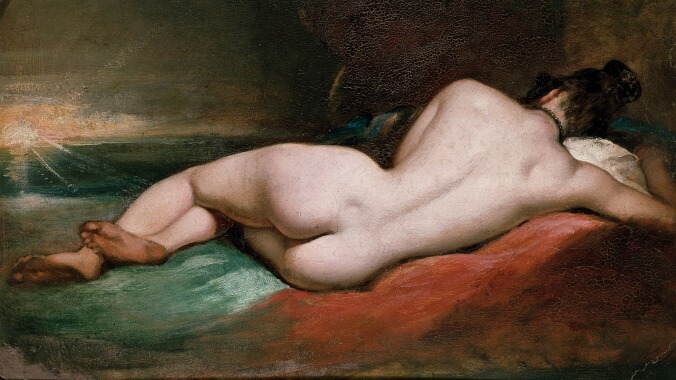This artist’s nudes gave him a bad reputation. His solution? Paint more nudes

This week’s entry: The Destroying Angel And Daemons Of Evil Interrupting The Orgies Of The Vicious And Intemperate
What it’s about: An 1832 painting by William Etty. Etty was the first English artist of note to paint nudes, and while critics admired his technique, the art world and the public alike were scandalized by his subject matter. He decided to quiet critics by painting a piece with a strong moral message. It also included quite a bit of nudity.
Biggest controversy: Art historians are bitterly divided over whether to consider Etty a Romantic painter or a Neoclassicist. We’re totally kidding, it’s the nudity. Unlike Italy, Greece, or France, England had no tradition of nude painting, and while some collectors had nudes by foreign artists, they weren’t widely seen by the public, and in fact were illegal under the 1787 Proclamation For The Discouragement Of Vice. Fourteen of Etty’s 15 exhibited paintings from the 1820s were nudes, and as Wikipedia says with typical understatement, “The reaction of the lower classes to these paintings caused concern.”
Strangest fact: To change his public perception as the immoral guy who paints nudes, Etty decided to become the overtly moral guy… who paints nudes. The Destroying Angel And Daemons Of Evil… (sometimes called The Destruction Of The Temple Of Vice for short), shows a temple full of nude human figures engaged in various vices, being attacked by demons, as an avenging angel destroys the temple with thunderbolts. (English novels of the time would often recount all sorts of salacious tales, and then punish the characters in the final chapter to show that all that tantalizing smut was in service of a moral lesson. Etty seems to have taken a similar tack.)
Thing we were happiest to learn: Apologizing for his nudes by creating a painting full of nude people totally worked. While some critics complained that the painting depicted violence against women, and that he “should not treat the fair sex in this harsh and wanton manner,” even those same critics called his work powerful and “drawn with exquisite skill.” His public perception changed overnight, as people saw him for the first time as someone with a strong moral sense. Some even saw The Destroying Angel as Etty symbolically punishing the nude figures of his previous works as a form of atonement. His post-Angel works included both nudes and moral lessons, so opinion was split on whether he was a good Christian or a pornographer.
Thing we were unhappiest to learn: The double standard was in full effect back in the 1830s. Etty’s female nudes were scandalous and indecent, but his male nudes were “generally well received.” His male nudes generally portrayed mythological heroes, and drew on an ancient Greek tradition that was well-respected in England. Whereas Youth On The Prow, And Pleasure At The Helm, a painting of a small sailboat full to overcapacity with naked women, was seen as lascivious smut, with The Morning Chronicle saying that Etty “should not persist, with an unhallowed fancy, to pursue Nature to her holy recesses… he has not taste or chastity of mind enough to venture on the naked truth.”
Also noteworthy: Courting controversy got Etty attention, fame, and fortune, throughout his whole life. But after a brief surge in popularity after his death, his paintings largely fell into obscurity. By the end of the 1800s, they were worth less than when he painted them, and only a few later painters cite him as an influence. The Destroying Angel did keep its value, however. Henry Payne, who commissioned the work for £12,000 in today’s money, and sold it 20 years later for the equivalent of £75,000. The buyer donated it to the Manchester Art Gallery in 1882, where it remains today.
Best link to elsewhere on Wikipedia: Long before Quentin Tarantino made it his stock in trade, artists were including homages to other artists in their work. One of the figures in Etty’s painting sits in the same position as the Barberini Faun, a famous third-century BC Greek sculpture (or Roman copy of same) with a fascinating history. It was discovered in the 1620s in a castle moat in Rome, below what was once Hadrian’s Mausoleum. During the 537 siege of Rome, defenders threw the mausoleum’s statues down on the invading Goths. The Faun is believed to have been one such. When it was found, the figure was missing a leg, parts of both hands, and part of its head, but was restored bit by bit over the next 150 years.
Further down the Wormhole: One of Etty’s rare paintings where everyone’s fully clothed is Preparing For A Fancy Dress Ball. A conservative politician commissioned Etty to paint a portrait of his daughters, and while an artist renowned for his nudes seems like an odd choice, Etty portrays two demure young women dressed up for a party. While “fancy dress” suggests a black-tie affair, it’s in fact what the English call a costume party. While dressing up was once limited for most people to such parties, Halloween, and Mardi Gras, people have taken to cosplaying at costume-friendly movies, a tradition that went mainstream with the much-anticipated Star Wars: Episode I – The Phantom Menace. 1999 was a such a good year for movies that All About My Mother, Being John Malkovich, Boys Don’t Cry, Buena Vista Social Club, Election, Fight Club, Magnolia, The Matrix, The Straight Story, The Talented Mr. Ripley, and Toy Story 2 are all classic films from that year that weren’t nominated for Best Picture. We’ll take a look at the most-popular, most-hyped, most-reviled, and most argued-over movie of that remarkable year next week.